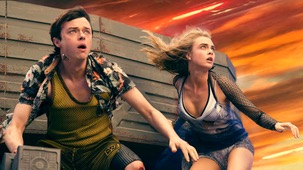To create something new, you have to experiment. Sometimes filmmakers accomplish this by going to extremes and rejecting narrative altogether (like Stan Brakhage’s experimental cinema); sometimes they do this by modifying – and subverting – mainstream conventions, like applying non-chronological story structures (Memento, Pulp Fiction) or following flat character arcs (Nightcrawler, No Country for Old Men).
But experimentation is different for you. As an imaging scientist, experimentation involves intense colour grading and digital rendering. It’s the kind of artistic lab work that can pay off in a movie like Valerian and the City of a Thousand Planets. And, for your part, it does. However, the other cinematic experiments going on in the midst of this sci-fi epic feel like they blew up in writer/director Luc Besson’s face.
That said, as pure science-fiction fantasy, Valerian passes many preliminary tests. Thanks in part to you, it’s beautiful to look at. The computer generated images pop off the screen with vibrant colour and high contrast. The creature designs are aesthetically appealing, bringing together a wide-variety of alien life-forms and space vessels to form Alpha (the titular City of a Thousand Planets). But the depth of these images, unfortunately, never applies to any of the characters themselves.
Part of this problem is the casting. In the hands of a more nuanced performer, Dane DeHaan’s Valerian might actually be convincingly smug and charming; a physically larger actor might have naturally had the sort of machismo DeHaan strains for, and not have been dwarfed by Cara Delevigne as Laureline.
It’s telling that Delevigne’s character – a co-headliner in the source material Valerian and Laureline – has had her name removed from the title and her agency stripped within the story. What could have been an interesting dynamic between the two characters is reduced to a simple question of “will she eventually cave in to his repeated advances and accept him for the man-child he is” (spoiler alert, of course she will). As a chemistry experiment, it’s a big failure.
But what about the physics? The action in the film is fairly inventive, especially a cross-dimensional foot chase through a barren desert and bustling intergalactic bazaar. The most appealing action, however, is probably Rihanna’s brief appearance as a shape-shifting burlesque dancer (an appearance that was pretty pointless from a plot perspective, but also the kind of tantalizing visual exercise you won’t ever hear me complain about).
While the film has its sporadic successes, the overall combination of these elements isn’t able to create the same sense of bizarre wonderment as Besson’s other sci-fi opera, The Fifth Element. Luckily, it seems one of form of experimentation in the film worked out: independently raising the money through international pre-sales to make the $200M budget virtually bullet-proof.
So congratulations for that innovation, at least.
Sincerely,

Christopher







